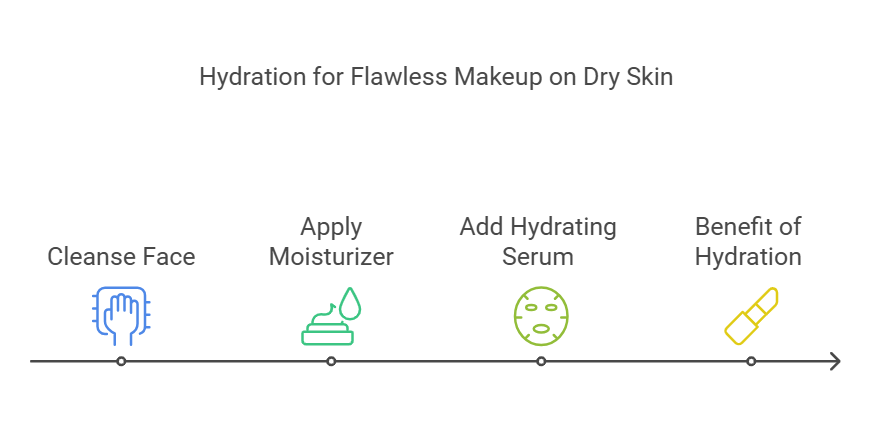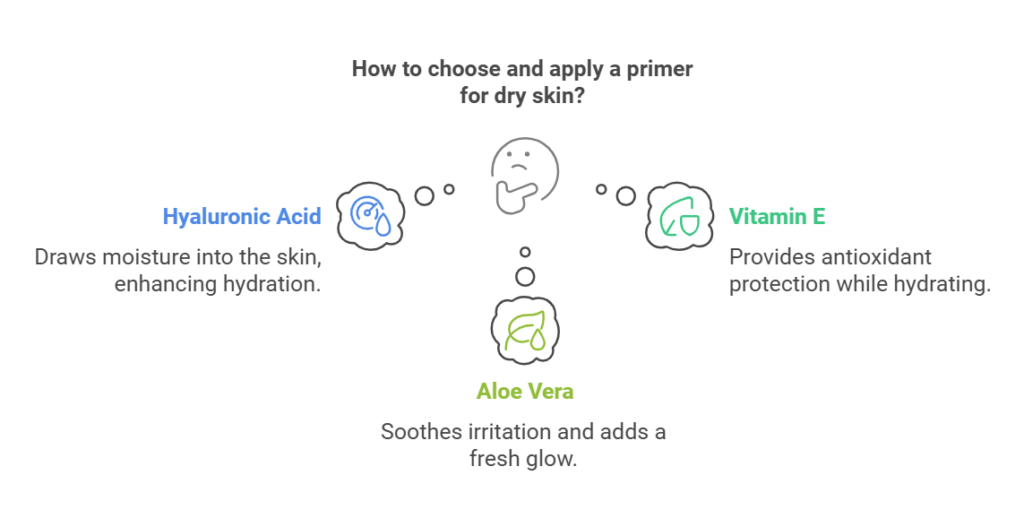
Introduction
Applying makeup on dry skin can feel like a constant battle against flakiness, patchiness, and a dull finish. Instead of a radiant glow, you may end up highlighting dry spots and rough textures. But worry not—your beauty routine doesn’t have to be compromised!
With the right techniques and carefully chosen products, you can create a smooth, dewy, and long-lasting makeup look. This guide will reveal dry skin makeup tips that will transform your routine, ensuring hydration and radiance from start to finish.
Hydrate Your Skin Before Makeup

Proper hydration is the foundation of flawless makeup for dry skin. Start by cleansing your face with a gentle, hydrating cleanser that doesn’t strip away natural oils. Follow up with a rich moisturizer packed with ingredients like hyaluronic acid, glycerin, and ceramides to lock in moisture.
Why is this important? Hydrated skin prevents flakiness and improves the blending ability of foundation, allowing products to sit evenly without clinging to dry patches.
Pro Tip: Layer a hydrating serum under your moisturizer for extra moisture retention. Products containing squalane or niacinamide are ideal for adding hydration.
Prime Your Skin for a Smooth Base

A primer acts as a barrier between your skin and makeup, ensuring a smooth and even application. For dry skin, it’s essential to pick a primer specifically designed for hydration and illumination.
Look for ingredients like:
- Hyaluronic Acid – Draws moisture into the skin.
- Vitamin E – Provides antioxidant protection while hydrating.
- Aloe Vera – Soothes irritation and adds a fresh glow.
Application Tip: Apply the primer with your fingertips to allow the warmth of your hands to melt it into the skin for better absorption.
Opt for a Hydrating Foundation

Dry skin craves moisture, so avoid matte or powder foundations that can accentuate dryness. Instead, go for liquid or cream foundations labeled “dewy” or “hydrating.”
Key Features to Look for:
- Oil-based formulas – Ideal for adding nourishment.
- Medium-to-full coverage – To conceal imperfections without emphasizing dryness.
- SPF-infused products – Protects skin while adding moisture.
Application Tip: Use a damp beauty blender to press the foundation into your skin. This technique avoids streakiness and adds extra hydration.
Avoid Heavy Powders
Setting powders can absorb moisture and make dry skin look even drier. Instead, use lightweight, translucent powders sparingly and only on areas prone to oiliness, such as the T-zone.
Better Alternatives:
- Hydrating setting sprays – Lock makeup in place without drying the skin.
- Dewy finishing mists – Maintain a natural, glowing finish.
Pro Tip: For an extra boost of glow, mix a drop of facial oil with your foundation before application.
Use Cream-Based Blush and Contour Products
Powder formulas often emphasize dry patches, while cream-based products blend seamlessly, providing a natural, hydrated finish.
Why Creams Work Better:
- They melt into the skin, mimicking its natural texture.
- They’re easier to blend without dragging or tugging.
Recommended Ingredients:
- Shea Butter – Moisturizes while adding color.
- Vitamin E – Protects against environmental stressors.
Pro Tip: Use your fingers or a beauty sponge to blend cream blushes and contours for a seamless look.
Highlight with Liquid or Cream Highlighters
For a glowing complexion, liquid or cream highlighters are better than powders. They provide a dewy finish that complements dry skin beautifully.
How to Apply:
- Dab onto the high points of your face—cheekbones, brow bones, and the tip of your nose.
- Blend with your fingertips or a sponge for a natural glow.
Bonus Tip: Add a small amount of highlighter to your foundation for an all-over radiant look.
Exfoliate Regularly for a Smooth Canvas
Dead skin cells can create a rough texture, making makeup application uneven. Exfoliate once or twice a week using a gentle chemical exfoliator containing AHAs (alpha hydroxy acids) or BHAs (beta hydroxy acids).
Avoid Harsh Scrubs: Physical scrubs can irritate dry skin and cause micro-tears.
Don’t Forget Lip Care
Dry lips can ruin an otherwise flawless look. Keep them soft and hydrated with a lip scrub followed by a nourishing lip balm.
Pro Tip: Avoid matte lipsticks, as they can emphasize dryness. Opt for creamy or satin-finish formulas instead.
Set Your Makeup with Hydrating Setting Spray
Skip traditional setting sprays that may contain alcohol and opt for hydrating mists that lock in moisture while extending makeup wear.
Ingredients to Look For:
- Rose Water – Refreshes and hydrates.
- Glycerin – Keeps skin plump and moist.
Conclusion
Dry skin doesn’t have to limit your makeup routine. By focusing on hydration, choosing cream-based formulas, and avoiding heavy powders, you can achieve a radiant, smooth, and long-lasting finish. These dry skin makeup tips ensure your skin stays nourished and glowing all day.
Whether you’re preparing for an everyday look or a glamorous evening out, these tips will help you embrace flawless makeup without worrying about dryness. Try them out and let your beauty shine!
FAQs
What type of foundation is best for dry skin?
Liquid or cream-based foundations with hydrating properties work best. Look for ingredients like hyaluronic acid or glycerin.
How do I keep my makeup from looking flaky?
Exfoliate regularly, hydrate your skin, and use cream-based products for a smoother finish.
Should I use powder if I have dry skin?
Avoid heavy powders. Instead, use hydrating setting sprays to lock in makeup without drying out your skin.
What’s the best way to make dry lips look smooth?
Exfoliate with a lip scrub and apply a moisturizing balm before adding lipstick.
Can I use facial oils under makeup?
Yes, facial oils can be mixed with foundation or applied before makeup to boost hydration.
What’s the best blush for dry skin?
Cream or liquid blushes work best as they blend easily and keep the skin looking fresh and hydrated.
